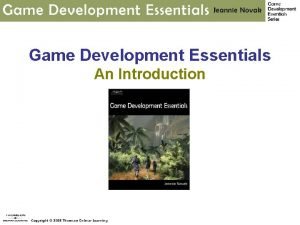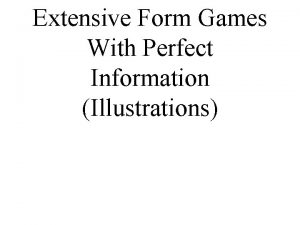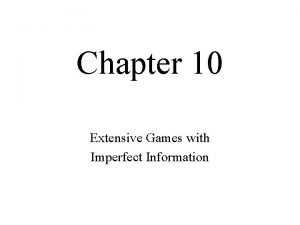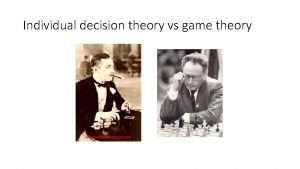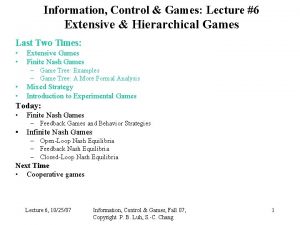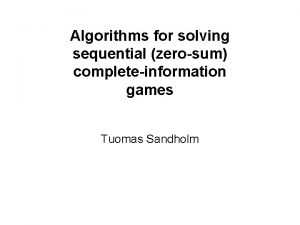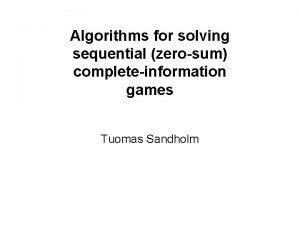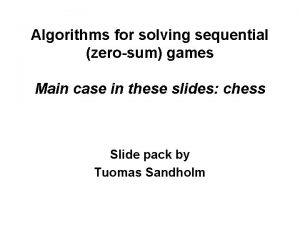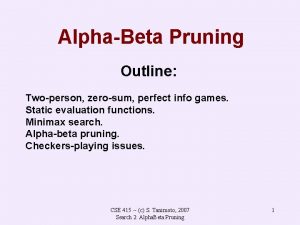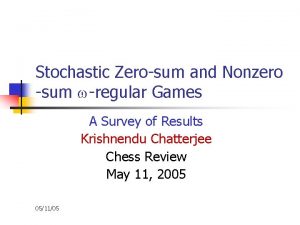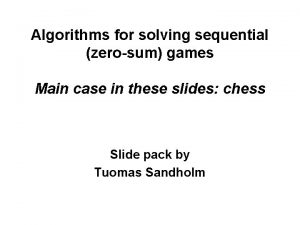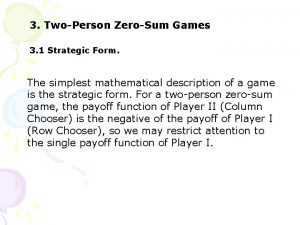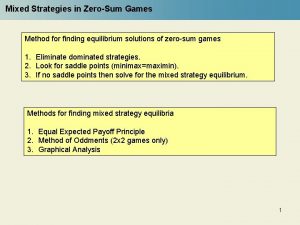Zerosum Games The Essentials of a Game Extensive



























- Slides: 27

Zero-sum Games • • The Essentials of a Game Extensive Game Matrix Game Dominant Strategies Prudent Strategies Solving the Zero-sum Game The Minimax Theorem

The Essentials of a Game 1. Players: We require at least 2 players (Players choose actions and receive payoffs. ) 2. Actions: Player chooses i from finite a set actions, of=S {s 1, s 2, …. . , sn}. Player j chooses from a finite set of actions T = {t 1, t 2, ……, tm}. 3. Payoffs: Wedefine. Pi(s, t)asthepayofftoplayeri, if. Playeri chooses s and player j chooses t. We require that ZERO-SUM Pi(s, t) + Pj(s, t) = 0 for all combinations of s and t. What 4. choosing actions.

The Essentials of a Game 4. Information: What players know (believe) when choosing actions. Perfect Information: Players know • their own payoffs Common Knowledge • other player(s) payoffs • the history of the game, including other(s) current action* *Actions are sequential (e. g. , chess, tic-tac-toe).

Extensive Game Player 1 chooses Player 2 Player 1 a = {1, 2 or 3} “Square the Diagonal” b = {1 or 2} (Rapoport: 48 -9) c = {1, 2 or 3} Payoffs = a 2 + b 2 + c 2 -(a 2 + b 2 + c 2) Player 1’s decision nodes 1 1 if /4 leaves remainder of 0 or 1. if /4 leaves remainder of 2 or 3. 1 2 3 Player 2’s decision nodes 2 2 3 -3 -6 -11 -6 9 -14 9 12 17 -11 -14 -19 -14 17 -22 GAME 1.

Extensive Game How should the game be played? Solution: a set of “advisable” strategies, one for each player. Start at the final decision nodes (in red) 1 1 1 2 3 Backwards-induction 2 2 3

Extensive Game How should the game be played? Solution: a set of “advisable” strategies, one for each player. Player 1’s advisable strategy in red 1 1 1 2 3 Player 2’s advisable strategy in green 2 2 3

Extensive Game How should the game be played? If both player’s choose their advisable (prudent) strategies, Player 1 will start with 2, Player 2 will choose 1, then Player 1 will choose 2. The outcome will be 9 for Player 1 (-9 for Player 2). If a player makes a mistake, or deviates, her payoff will be less. 1 1 1 2 3 2 2 3 -3 -6 -11 -6 9 -14 9 12 17 -11 -14 -19 -14 17 -22 GAME 1.

Extensive Game A Clarification: Rapoport (pp. 49 -53) claims Player 1 has 27 strategies. However, if we consider inconsistent strategies, the actual number of strategies available to Player 1 is 37 = 2187. An inconsistent strategy includes actions at decision nodes that would not be reached by correct implementation at earlier nodes, i. e. , could only be reached by mistake. Since we can think of a strategy as a set of instructions (or program) given to an agent or referee (or machine) to implement, a complete strategy must include instructions for what to do after a mistake is made. This greatly expands the number of strategies available, though the essence of Rapoport’s analysis is correct.

Extensive Game Complete Information: Players know their own payoffs; other player(s) payoffs; history of the game excluding other(s) current action* *Actions are simultaneous 1 1 1 2 3 Information Sets 2 2 3 -3 -6 -11 -6 9 -14 9 12 17 -11 -14 -19 -14 17 -22 GAME 1.

Matrix Game T 1 Also called “Normal Form” or “Strategic Game” S 11 S 12 S 13 S 21 S 22 S 23 S 31 S 32 S 33 T 2 Solution = {S 22, T 1}

Dominant Strategies Definition Dominant Strategy: a strategy that is best no matter what the opponent(s) choose(s). T 1 T 2 T 3 S 1 -3 0 1 S 1 -3 0 -10 S 2 -1 5 2 S 3 -2 2 0 S 3 -2 -4 0

Dominant Strategies Definition Dominant Strategy: a strategy that is best no matter what the opponent(s) choose(s). T 1 T 2 T 3 S 1 -3 0 1 S 1 -3 0 -10 S 2 -1 5 2 S 3 -2 2 0 S 3 -2 -4 0 Sure Thing Principle: If you have a dominant strategy, use it!

Prudent Strategies T 1 T 2 T 3 S 1 -3 1 -20 S 2 -1 5 2 S 3 -2 -4 15 Definitions Prudent Strategy: A prudent strategy for player i maximizes the minimum payoff she can get from playing different strategies. Such a strategy is simply maxsmint. P(s, t) for player i. Player 1’s worst payoffs for each strategy are in red.

Prudent Strategies T 1 T 2 T 3 S 1 -3 1 -20 S 2 -1 5 2 S 3 -2 -4 15 Definitions Prudent Strategy: A prudent strategy for player i maximizes the minimum payoff she can get from playing different strategies. Such a strategy is simply maxsmint. P(s, t) for player i. Player 2’s worst payoffs for each strategy are in green.

Prudent Strategies T 1 T 2 T 3 S 1 -3 1 -20 S 2 -1 5 2 S 3 -2 -4 15 Definitions Prudent Strategy: A prudent strategy for player i maximizes the minimum payoff she can get from playing different strategies. Such a strategy is simply maxsmint. P(s, t) for player i. Saddlepoint: We call the solution {S 2, T 1} a saddlepoint A set of prudent strategies (one for each player), s. t. (s’, t’) is a saddlepoint, iff maxmin = minmax.

Prudent Strategies Saddlepoint: S 1 -3 1 -20 S 2 -1 5 2 S 3 -2 -4 15 A set of prudent strategies (one for each player), s. t. (s’, t’) is a saddlepoint, iff maxmin = minmax.

Mixed Strategies Player 1 Left Player 1 hides a button in his Left or Right hand. Right Player 2 L -2 R 4 L 2 R -1 GAME 2: Button-Button Player 2 observes Player 1’s choice and then picks either Left or Right. Draw the game in matrix form.

Mixed Strategies Player 1 Left Player 1 has 2 strategies; Player 2 has 4 strategies: Right Player 2 L -2 R 4 L 2 R -1 GAME 2: Button-Button L LL RL -2 RR LR 4 -2 4 R 2 -1 -1 2

Mixed Strategies Player 1 Left The game can be solve by backwards-induction. Player 2 will … Right Player 2 L -2 R 4 L 2 R -1 GAME 2: Button-Button L LL RL -2 RR LR 4 -2 4 R 2 -1 -1 2

Mixed Strategies Player 1 Left The game can be solve by backwards-induction. … therefore, Player 1 will: Right Player 2 L -2 R 4 L 2 R -1 GAME 2: Button-Button L LL RL -2 RR LR 4 -2 4 R 2 -1 -1 2

Mixed Strategies Player 1 Left Right L L R -2 4 2 -1 Player 2 L -2 R 4 L 2 R -1 GAME 2: Button-Button R What would happen if Player 2 cannot observe Player 1’s choice?

Solving the Zero-sum Game L R L -2 4 R 2 -1 Definition Mixed Strategy: A mixed strategy for player i is a probability distribution over all strategies available to player i. Let (p, 1 -p) = prob. Player I chooses L, R. (q, 1 -q) = prob. Player 2 chooses L, R. GAME 2.

Solving the Zero-sum Game L Then Player 1’s expected payoffs are: R L -2 4 (p) R 2 -1 (1 -p) (q) (1 -q) EP(L) = -2(p) + 2(1 -p) = 2 – 4 p EP(R) = 4(p) – 1(1 -p) = 5 p – 1 4 EP EP(R) = 5 p – 1 2 0 -1 GAME 2. p*=1/3 1 p -2 EP(L) = 2 – 4 p

Solving the Zero-sum Game L L -2 Player 2’s expected payoffs are: R 4 (p) EP(L) = 2(q) – 4(1 -q) = 6 q – 4 EP(R) = -2(q) + 1(1 -q) = -3 q + 1 EP(L) = EP(R) R 2 -1 (q) (1 -q) GAME 2. (1 -p) => q* = 5/9

Solving the Zero-sum Game Player 1 Player 2 EP(L) = -2(p) + 2(1 -p) = 2 – 4 p EP(R) = 4(p) – 1(1 -p) = 5 p – 1 EP(L) = 2(q) – 4(1 -q) = 6 q – 4 EP(R) = -2(q) + 1(1 -q) = -3 q + 1 -EP 2 EP 1 4 -4 2 0 -1 2/3 = EP 1* = - EP 2* =2/3 p p*=1/3 This is the -2 Value of the game. 2 -2 q*= 5/9 1 2 q

Solving the Zero-sum Game Then Player 1’s expected payoffs are: L R L -2 4 (p) R 2 -1 (1 -p) (q) (1 -q) GAME 3. (Security) Value: the expected EP(T 1) = -2(p) + 2(1 -p) payoff when both (all) players play EP(T ) = 4(p) – 1(1 -p) prudent strategies. 2 EP(T 1) = EP(T 2) => p* = 1/3 Any deviation by an opponent leads to an. Player equal 2’s or greater payoff. And expected payoffs are: (V)alue = 2/3

The Minimax Theorem Von Neumann (1928) Every zero sum game has a saddlepoint (in pure or mixed strategies), s. t. , there exists a unique value, i. e. , an outcome of the game where maxmin = minmax.
 Nash equilibrium definition
Nash equilibrium definition Game development essentials an introduction
Game development essentials an introduction The hunger games chapter 3 questions
The hunger games chapter 3 questions Types of games indoor and outdoor
Types of games indoor and outdoor What is game sense in video games
What is game sense in video games Sơ đồ cơ thể người
Sơ đồ cơ thể người So nguyen to
So nguyen to đặc điểm cơ thể của người tối cổ
đặc điểm cơ thể của người tối cổ Tỉ lệ cơ thể trẻ em
Tỉ lệ cơ thể trẻ em Vẽ hình chiếu vuông góc của vật thể sau
Vẽ hình chiếu vuông góc của vật thể sau Các châu lục và đại dương trên thế giới
Các châu lục và đại dương trên thế giới ưu thế lai là gì
ưu thế lai là gì Môn thể thao bắt đầu bằng chữ đua
Môn thể thao bắt đầu bằng chữ đua Tư thế ngồi viết
Tư thế ngồi viết Hát kết hợp bộ gõ cơ thể
Hát kết hợp bộ gõ cơ thể Cái miệng nó xinh thế
Cái miệng nó xinh thế Cách giải mật thư tọa độ
Cách giải mật thư tọa độ Tư thế ngồi viết
Tư thế ngồi viết V. c c
V. c c Voi kéo gỗ như thế nào
Voi kéo gỗ như thế nào Thẻ vin
Thẻ vin Thể thơ truyền thống
Thể thơ truyền thống Hổ đẻ mỗi lứa mấy con
Hổ đẻ mỗi lứa mấy con Từ ngữ thể hiện lòng nhân hậu
Từ ngữ thể hiện lòng nhân hậu Thế nào là hệ số cao nhất
Thế nào là hệ số cao nhất Diễn thế sinh thái là
Diễn thế sinh thái là Vẽ hình chiếu vuông góc của vật thể sau
Vẽ hình chiếu vuông góc của vật thể sau Frameset trong html5
Frameset trong html5

